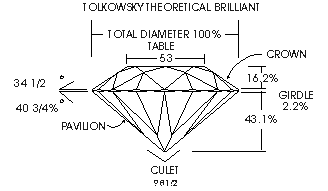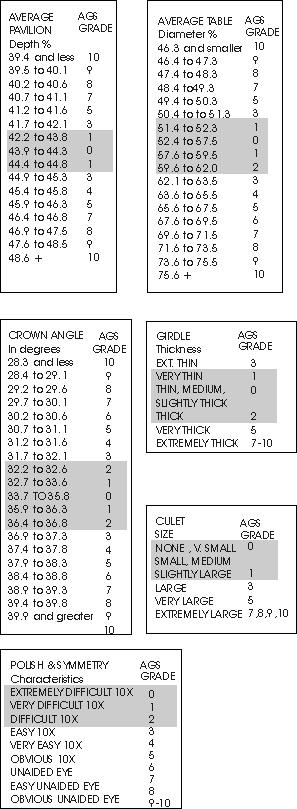|
History
of the Ideal Cut: The earliest guidelines
for diamond fashioning were based more on
aesthetics than science, but in 1900 the
round brilliant had evolved into something
very close to its current form. No formal
work on the relationships between optics
and diamond cutting appeared until the twentieth
century. Then much later, in 1919, Marcel
Tolkowsky -- a member of a Belgian cutting
family -- published a short paper entitled
Diamond Design. This was the first analysis
of diamond cutting based on modern science
theories of light behavior.
 Although
Diamond Design was first published in England,
Tolkowsky�s design is often called the �American
Ideal Cut� because US cutters were the
first to produce it in significant quantities.
In the e 1950�s, AGS adopted Tolkowsky�s
model as its standard for grading cut.
The only modifications to the basic design
were establishing limited ranges for table
size, crown height, pavilion depth and girdle
thickness. In 1955, the updated model
was renamed the AGS Ideal Cut. Although
Diamond Design was first published in England,
Tolkowsky�s design is often called the �American
Ideal Cut� because US cutters were the
first to produce it in significant quantities.
In the e 1950�s, AGS adopted Tolkowsky�s
model as its standard for grading cut.
The only modifications to the basic design
were establishing limited ranges for table
size, crown height, pavilion depth and girdle
thickness. In 1955, the updated model
was renamed the AGS Ideal Cut.
The demand for AGS Ideal has increased substantially
and today numerous cutters around the world
are producing designs loosely referred to
as �Ideal Cuts.� The standards for these
�ideals� vary significantly, and as a result,
the ability to recognize and evaluate diamond
cutting variations is even more important
than it was a decade ago. The popularity
of �ideal cuts� and the increased consumer
demand for verification of this quality
factor were among the primary reasons for
establishing the AGS Laboratory .
Opened in 1995, the lab has grown quickly
because it is the only US facility that
addresses cut grading in diamond in Diamond
Quality Documents. (GIA Gem Trade
Laboratory), the primary industry source
for diamond quality documentation does not
address the issue of cut grade in its reports.
American Gem Society (AGS)
The American Gem Society (AGS) Diamond Grading
Laboratory uses a cut grade system that
assigns diamonds a cut grade as a number
between 0 and 10. The AGS Cut Grade reflects
the impact of 3 key elements on a diamonds
beauty and value
-
proportions
-
symmetry
-
polish
Proportions are the sizes and angles
of the diamond�s main parts. Symmetry
is the balance and evenness of its faceting
and shape. Polish refers to the diamond�s
surface quality, including the presence
or absence of characteristics such as abrasions,
scratches, nicks and polish wheel lines
The AGS Ideal 0 cut grade represents
the very best in diamond cutting.
AGS 0 is only assigned to a diamond in which
correct proportions, precise symmetry and
fine polish are combined to produce an optimum
display of brilliance, scintillation and
dispersion. The impression is a harmonious
balance between the physical dimensions
of the diamond and the optical components
of its beauty.
As diamonds fall into grades further from
O (ideal), their relationship to beauty
begins to diminish. For example, a diamond
with a cut grade of 1 or 2 (very fine cut)
are very close to 0 in appearance. A cut
grade 5 diamond has variations that detract
significantly from overall appeal. It may
appear somewhat �washed out� or slightly
dark through the center. Cut grades 10 are
the worst examples of proportioning, symmetry
and polish; so they have little visual �life.�
 There
are five factors to consider in evaluation
proportions: There
are five factors to consider in evaluation
proportions:
-
Table Size
-
Crown Angle
-
Girdle Thickness
-
Pavilion Depth%
-
Culet Size
Diagram shows AGS cut grade 0 (ideal), AGS
grade 1 and 2 (very fine) Highlighted in
Gray
To evaluate a diamond�s proportions, simply
measure each factor, one at a time, and
assign it�s appropriate grade using the
proportions grade chart shown. The lowest
of the five grades (the highest number)
will be the diamonds overall proportion
grade. To receive a grade 0 and diamonds
must fit into the perimeters shown for 0
in all five categories.
We
suggest selecting a diamond
that is cut grade 0 (ideal) or cut grade
1 or 2 (very fine). If
you desire a cut grade 0 (ideal cut), it
will usually cost 10 to 15% more than most
diamonds with the same color and clarity
grades with cut grades 1 or 2 (very fine)
The added cost you pay for a 0 grade (ideal)
is a result of the additional manufacturing
time the cutter is forced to expend when
finishing a diamond to exact tolerances
and the small supply of 0 grade (ideal)
diamonds that are available. AGS 0 grade
(ideal) diamonds in large sizes and high
qualities over 1 1/2 carats in size are
difficult to find in the market today.
|